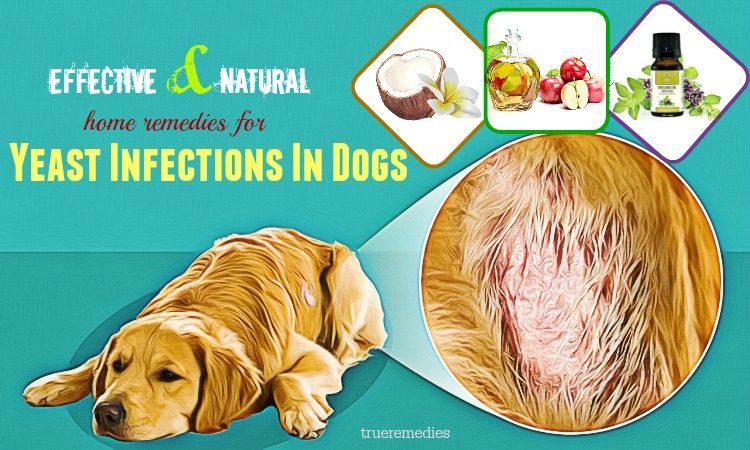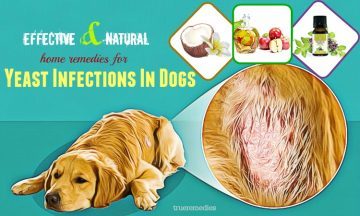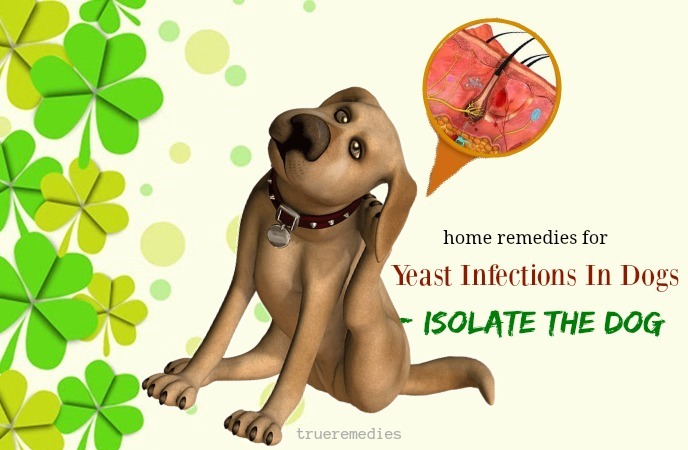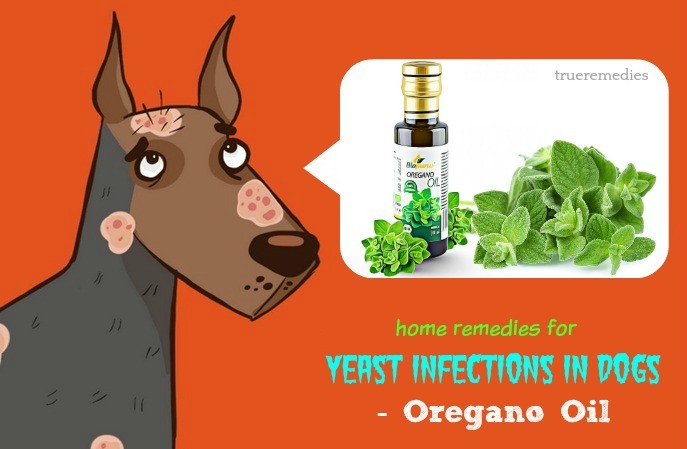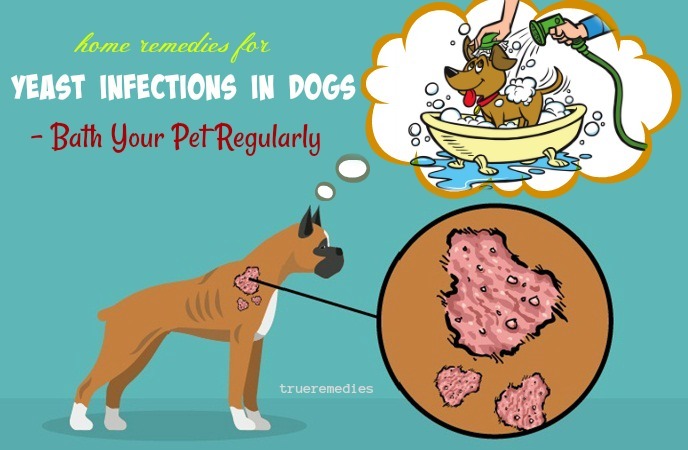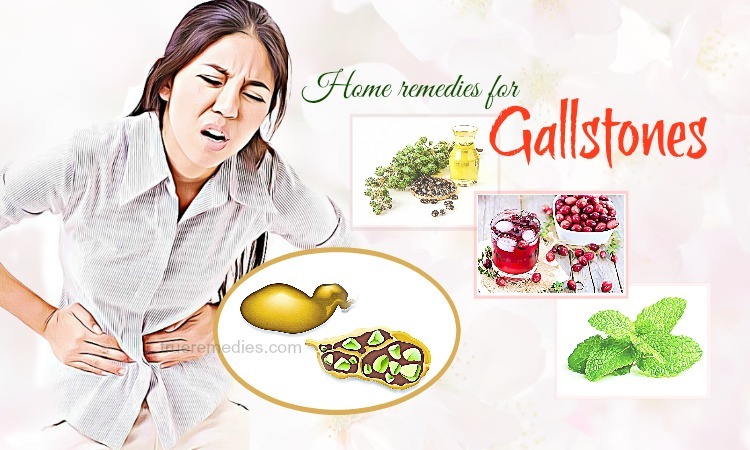Contents
If your dog is itchy, irritable and has a slightly foul odor, he can be infected with yeast. This condition causes extreme discomfort and may involve some basic problems such as allergies or endocrine disorders.
As a result of the studies, all yeast strains are fungi. They usually live on the dog's body without causing any disease. However, problems will arise when there are too many fungi on the dog's body. A yeast infection will limit the quality of life of your dog.
To help you find out the solution for this condition in dogs, we introduce a list of 10 effective home remedies for yeast infections in Dogs. However, before beginning, it is important to grasp some basic information about it.
What Are Yeast Infections In Dogs?
One of the biggest challenges that pet owners may face is yeast infection in dogs. This is one of many possible causes to explain why dogs are scratching and biting throughout their body. According to the researchers, all yeast strains are fungi. Yeast along with hundreds of good and bad fungi often lives inside and outside the pets as an essential part of the natural flora of animals. Once the balance of these good and bad creatures is broken, the yeast will often take advantage of this loophole to begin to multiply and grow.
There are many things that can break the natural flora, including the feeding of too much starch, the use of antibiotics or dogs with immune system diseases such as adenomyosis armor. While it is important to find out the root cause of overgrowth of dog fungus, you can start training your dog to take some supplements to help him fight fungus. It also reinforces rebalancing the immune system in dogs.
Remember that you should check with your veterinarian about the dosage you should take for your dog and always start slowly.
TrueRemedies Partner Solutions

Need a Help from the Leading Expert Online, Available 24/7?
They’re all here and ready to answer your questions online or by phone. Keep asking questions until you get the answer you need.
What Are Common Causes Of Yeast Infections In Dogs?
Here are common causes of this condition:
- A non-scientific diet
- Weakened immune system
- Allergy
- Tumors or polyps in the ear canal
- An object stuck
- Poor hygiene
- Frequent contact with wet environment
- Infection
- An eardrum is broken
What Are Common Symptoms Of Yeast Infections In Dogs?
Here are common symptoms of this condition:
- Changes In Skin Color And Texture
Symptoms of yeast infection in dogs are varied, depending on the location affected. However, the most common sign of this condition is a change in the color and texture of the dog’s skin. In the early stages, the skin of the dog may be pink or red. In case of chronic infection, the dog's skin may become thick, gray or black. Yeast infections can occur in many places on the dog's body so you need to check carefully for early diagnosis.
- Greasy Skin
The next symptom of yeast infection in dogs is greasy skin. You can easily recognize this sign, especially when you see the dog's hair sticking to its skin.
- Scaly Skin
In most cases of yeast infection in dogs, the skin can be scaly like dandruff.
- Head Shaking
Dogs are prone to yeast infections in their ears. This condition causes the dog to be irritated and itch, so he often shakes his head. You can easily recognize this sign because it is a way for him to feel more comfortable.
- Scratching And Rubbing
When your dog is infected with yeast, he usually feels very itchy. That's why he can constantly scratch the affected area and rub it on furniture or scoot along the floor.
- Licking
Some yeast-infected dogs may try to minimize their discomfort by constantly licking for infected areas.
- Swelling And Warmth
Redness and itching are initial signs of yeast infection in dogs. They can lead to swelling and warmth in the affected area.
- Odor
Odor is also a common symptom of yeast infection in dogs. Some people find that smell is like Cheetos, while others find it smells sweet.
- Hair Loss
Hair loss seems to be unavoidable if the dog is infected with yeast.
- Drooling
If the yeast infection occurs in the mouth, the dog may drool constantly. Besides, they will also get upset whenever they eat or drink. However, excessive salivation may also be a sign of other oral diseases.
Your dog may experience other symptoms not mentioned. If you have any questions about the signs of the disease, please consult your doctor.
What Are Risk Factors?
Yeast infection is quite common in dogs. Dogs that are usually exposed to wet environments and not regularly bathed are often at high risk.You can control this problem by minimizing risk factors for your dog.
When To See A Vet?
As soon as you notice the signs of yeast infection in dogs, you should take him to the vet. Identifying the right disease early will help you choose the right treatments for him. This also helps to prevent the spread. Besides, if you have any questions about yeast infection in dogs, please consult the vet.
There, you have discovered some information about yeast infections in dogs. Now is the time to find out home remedies that help treat this condition for your pet. Please take a look at TrueRemedies.com!
Top 26 Effective Home Remedies For Yeast Infections In Dogs’ Ears, Paws & Feet
1. Isolate The Dog To Prevent Yeast From Spreading To Other Pets
Isolating your dog is the first remedy in this list of natural home remedies for yeast infections in dogs’ ears, paws and feet.
If the dog is infected with yeast, you need to isolate him from other pets to prevent infection. Make sure the dog is safe and warm. Do not isolate the dog by leashing him outside or letting him in an unheated place in the winter. Choose a room in the house to isolate the dog while treating the yeast infection.
Provide food, water, sleeping areas and toys for the dog while he is isolated. Be sure to spend time with him, take a walk and play with him, so the dog does not feel frightened by quarantine. In rare cases, people may get yeast infections from dogs. Protect yourself by wearing gloves when handling dogs.
2. Shave The Injured Skin Hair With An Electric Shaver
Among home remedies for yeast infection in dogs, this is one of the most effective.
You should do this before applying any skin treatments for your dog. If the dog's hair is too long, you need to shave it so that it can be safely cleaned. Without an electric shaver, you can use a scissors to cut the dog's hair. However, avoid cutting too deep so as not to cause additional injury to the injured area
Shaving the injured area helps you see the wound better and prevents the dirt from accumulating and stimulating the skin.
3. Coconut Oil
Using coconut oil is another must-try option among home remedies for yeast infection in dogs’ ears, paws and feet.
The benefits of coconut oil for humans are widespread on blogs and television shows about health. Therefore, pet nutrition experts along with pet owners also recognize that coconut oil also helps a lot when used on cats and dogs. So how good is coconut oil?
Coconut oil contains large amounts of glycerol chains, which are commonly used to make lauric acid, capric acid, caprylic acid, myristic acid, and pamitic. All these substances empower coconut oil powerful antibacterial, antifungal and antiviral properties.
In dogs, the medium chain fatty acids (MCFAs) in coconut oil can balance the thyroid, thereby helping those overweight dogs lose weight and assisting sedentary dogs in feeling energetic. Because yeast is a fungus, coconut oil can help prevent and treat its overgrowth [1].
Coconut oil can be added to the pet's diet as well as applied directly to the dog's skin. This remedy is especially useful if your dog is allergic to certain chemicals. This oil is absolutely safe for dogs and all other animals. However, if your dog is suffering from a health condition, you should check with your vet prior to using coconut oil or any new supplements. You ought to choose extra virgin or virgin coconut oil for good results.
To make use of coconut oil for yeast infections in dogs, you can let your dog lick coconut oil off the spoon or mix it into his food. By adding coconut oil to your food, you can prevent digestive upset when you initially start giving it to your dog.
4. Kefir
Kefir is originated from grains of many vitamins and minerals and contains up to 30 different types of bacteria and yeast. Kefir is rather similar to yogurt. It is abundant in probiotics, including beneficial bacteria such as Lactobacillus Caucasus, Leuconostoc, Acetobacter species and Streptococcus, Yeast-like Saccharomyces kefir, and Torula kefir [2].
Although the nature of kefir is very good, be sure to incorporate it steadily into your dog's diet to minimize possible side effects.
5. Apple Cider Vinegar
The next one in this list of home remedies for yeast infection in dogs ’ ears, paws and feet is using apple cider vinegar.
Apple cider vinegar is known for a variety of uses, including everything from being used to mixing salads to cleaning dirty clothes. So it is not surprising that apple cider vinegar has long been used as a powerful antidote against yeast in animals.
The FDA showed that apple cider vinegar has only trace amounts of animals and minerals, except for potassium. However, in spite of not being consisted of essential nutrients, apple cider vinegar has health benefits for both humans and animals. Its strong antibacterial and antioxidants properties are enough reason to add it to the care regime of your dog [3].
To use cider vinegar to treat yeast infections in dogs, you can do the following:
- After bathing the dog, use apple cider vinegar to bathe him again.
- Use apple cider vinegar to wash your dog's ears if he is infected with yeast in the ear.
- Add apple cider vinegar to dog food to enhance the therapeutic effect.
The most important thing is to buy organic, pure, and unfiltered apple cider vinegar.
If you have a dog that likes to play with water (yeast loves damp places), apple cider vinegar is the best remedy. After the dog is out of the pool for a day, fill the apple cider vinegar with a squeeze bottle. Place the bottle close to the dog's hair and squeeze the apple cider vinegar out. Massage your dog's body. This will restore the pH of your dog as well as prevent the yeast from growing.
Then, once a week (or more if needed), massage the yeast-infected area of the dog with apple cider vinegar. You can add 10 drops of lavender essential oil and 2 drops of lemon essential oil to enhance the effect. This mixture can be used throughout the summer. Keep it in a dark place, not let the sun go in.
Also read: 10 Natural Home Remedies For Parvo In A Dog
6. Pau D'arco
Using Pau D’arcois one of little – known home remedies for yeast infection in dogs.
This type of immune enhancer is derived from a plant species in tropical rain forests in South America. Used in the treatment of all types of allergic diseases, HIV infection and Parkinson's tremor, there is no doubt that this herb was introduced to help fight yeast infections in dogs.
Pau d'arco is available in many supplements, but it is important that you find the high quality supplements that contain this herb.
7. Oregano Oil
Due to its widespread availability of antibiotics, oregano oil is also a strong antifungal agent. Oregano oil can be used locally, and in food or in water. Even a small amount of this oil will help, especially when used to feed the dog. Your pet dog may not like the smell of this oil, so be sure to just put a few drops of oil in the dog's food so that it does not smell [4].
In addition, as the quality of oregano oil decreases during processing, be sure to thoroughly research the oil before buying it.
8. Give Your Dog Medications And Other Treatments As Directed By A Veterinarian
The treatment for the dog will depend on the type of yeast infection and is only determined by the licensed veterinarian. Some dogs require special baths, prescription medications or even injections to treat yeast infections. Be sure to follow the veterinarian's instructions while treating your dog and contact your doctor if you have any questions or concerns. Do not try to diagnose and treat the dog without the help of a veterinarian.
9. Muzzle The Dog If Necessary
In regard to home remedies for yeast infection in dogs, muzzling your dog is essential.
You need to protect yourself when applying dog treatments. On average, dogs can love and be friendly with you, but when they are hurt, the dog may be more aggressive to protect themselves from further damage. If the dog starts to snarl, or if he has a history of biting a person because it was agitated before, you should muzzle the dog to protect yourself.
If the dog is too excited and becomes more aggressive, stop and take the dog to the veterinary clinic immediately. Protect yourself by wrapping your dog in a blanket or towel when you take the dog to a veterinary clinic.
10. Wash Or Replace The Dog's Litter And Other Objects In Contact With The Dog
Among home remedies for yeast infection in dogs, this is one of the most effective.
To prevent recurrence, it is best to wash the dog's litter and other objects in contact with the dog with hot water, soap and bleach. This helps to ensure that the yeast is completely removed. For sure, you should do this 2 times.
11. Help The Dog Manage Psychological Stress During Treatment
This sounds strange when it comes to home remedies for yeast infection in dogs’ ears, paws and feet, but it really works.
When the dog is infected with yeast, you should control and calm the dog if the dog is too excited. Treat the dog by gentle caressing and grunting with the dog. You also have to be calm in spite of your dog's worries. Dogs can read the language and capture your tone very well. Therefore, dogs can react to your behavior and listen to you.
Yeast infections can make the dog suffer from itching, isolation, vet visits, medications and other treatments. This makes your dog very nervous and scared. When dogs are treated, you need to take action to keep the dog calm.
For example, you can reward dogs after bathing, remember to visit your dog regularly during quarantine and continue with routine activities with dogs such as walking or playing in the backyard.
12. Keep Your Dog Away From Yeast-Infected Dogs
The next treatment in this list of home remedies for yeast infection in dog is keeping your dog away from yeast infected dogs.
If you suspect a neighboring dog (or cat) is infected with yeast, you need to keep your dog away from it as much as possible. Talk to the owner of the pet you suspect is infected with yeast or call the pet control center if it is a stray pet.
13. Feed The Dog Food Balanced High Quality
As you know, an unbalanced diet can cause yeast infections in dogs. Therefore, pay more attention to your dog's diet. Look at the first five ingredients on the dog food package. These are the main ingredients in the food. Meat (not animal by-products) and vegetables should be among the first ingredients of dog food. The next list may be animal by-products and cereals.
Avoid foods that use fillers that may harm the health of the dog. Some of the ingredients include: Ethoxyquin, Propylene Glycol, BHT / BHA, Maize Soybean and Corn, as well as animal by-products.
Periodically, some dogs may develop symptoms of hypersensitivity or food intolerance. Observe signs of diarrhea, vomiting, or skin problems. Consult your veterinarian to determine the food ingredients that your dog may or may not be able to eat.
14. Be Careful When Feeding Your Dog Food
Be careful when feeding your dog food. Note that some types of human food may harm or deprive the life of dog. The dog's body cannot always convert food like humans, so make sure they do not eat the following foods: grapes, raisins, chocolate, butter, pastries, nuts, beer, onions, garlic, chives and sugarless gum (the main ingredient is xylitol). All of these are harmful to dogs.
Although you can make your own dog food, you must talk to an animal nutritionist or veterinarian with knowledge of animal nutrition. This ensures that the dog's diet is balanced in terms of nutrition.
15. Make Sure Your Dog's Weight Is Normal
The next treatment in this list of home remedies for yeast infection in dogs is making sure your dog's weight is normal.
Dogs with a weight that exceeds 10-20% of the optimal weight are considered overweight. If your dog's weight exceeds 20%, it is already obese. Obesity can reduce the age of dogs by 2 years. In addition to being prone to yeast infections, obese dogs are at risk for cancer, heart disease, diabetes, osteoarthritis and bladder stones.
Talk to your veterinarian about the ideal dog weight and feed them based on this criteria. Most dogs are overweight or obese due to lack of exercise and overeating. Check out the pet food packaging for specific instructions on feeding based on ideal weight.
16. Feed Dogs With Healthy Snacks
Snacks can add a calorie amount to the daily calorie allowance of the dog. This can make the dog overweight. You should feed your dog homemade junk food instead of buying food. Feed dogs with low calorie snacks such as small carrots, canned green beans (low in salt or washed to remove salt), or a few slices of boiled sweet potatoes.
Learn more: 22 Natural Home Remedies For Kennel Cough In Dogs
17. Provide Clean Water For Dogs
When it comes to home remedies for yeast infection in dogs, this remedy sounds too simple, but it is very important if you want to eliminate the condition quickly.
Pets need to drink plenty of water in order for the body to function and digest food normally. In addition, they need to drink clear water, so you should change the water at least once a day. Bacteria and algae can be produced in water bowls, especially in hot seasons. In the winter, you should avoid the bowl of frozen water.
18. Bath Your Pet Regularly
The next one among natural home remedies yeast infection in dogs is bathing your dog regularly.
Brush your dog to keep him shiny and healthy. This also promotes good blood circulation. Carefully examine your dog's skin for any skin conditions he may be experiencing, including yeast infections. When cleaning your dog, you can also check for skin problems such as fleas and ticks. You should also take him to a veterinarian if the skin is soaked, red or itchy.
The dog's hair usually grows very quickly and you need to take your dog to a shed. Hair that grows too long will irritate the toes, or obscure the dog's vision. In addition, the long hair may be easily entangled in the branches or leaves, making the dog uncomfortable.
Dirty hair can cause inflammation, so you should bathe your dog with mild soap if it gets dirty. Most dogs will only need to bathe once a month or more, but the cleaning time may vary depending on the breed and the particular activity.
Learn more: 14 Effective Home Remedies For Candida Yeast Infection Treatment
19. Cut The Dog's Nails
Among home remedies for yeast infection in dogs, this is one of the most effective.
This is not always easy, but you need to keep your dog's foot healthy. Perform slowly and regularly. The fact is that dogs will take time to get used to having their nails trimmed, but later on they will no longer feel uncomfortable with this. Be careful not to cut into the flesh pads of the nails which contain blood vessels and sensitive nerves.
Train the dog to link the pedicure action with a good experience. Feed them after the nail is cut. Regardless of the reward, you will always be positive in the process of cutting the nail for the dog, although this is not easy to do.
If you do not know how to cut the nail for the dog, you should ask your veterinarian for instructions.
20. Brush The Dog Daily
Brushing removes plaque or bacteria buildup in teeth. This is also a good time to check for wounds, damaged teeth, yeast infection or other problems in the dog’s mouth. Only use dog toothpaste. Fluoride in human toothpaste is toxic to dogs and can cause serious health problems.
Periodically, the dog also needs to visit the veterinary clinic for professional dental hygiene. For this procedure, the dog will be reassured at the veterinarian's check-in as well as thorough cleaning.
21. Check The Dog's Ears
Checking the dog’s ears is an essential step to take control of your dog’s yeast infection.
Dog ears should not have any strange odor or discharge. The inner ear should be white, but some dark-haired dogs have darker ears. The ear should not be covered by dirt, debris, or parasites such as ticks. Sometimes pieces of the trunk may fall into the ears of pets and should be carefully removed.
22. Clean The Dog's Ears
One of basic home remedies for yeast infection in dogs is maintaining good hygiene for your pet. One step you need to take is cleaning the dog’s ears.
Use a dedicated product to clean your dog's ears. You can also mix white vinegar with medical alcohol at a ratio of 1: 1 to do this. Dip the cotton wool into the solution and gently wipe the outer ear of the dog. As you know, yeast infections often occur in the ears of dogs. Consequently, regular cleaning the dog’s ears is essential.
If blood appears on the pad, stop cleaning and contact the vet. Continuous shaking or scratching the ears is unusual. If you suspect your dog has an ear infection or other ear problem, you should take them to the vet.
Don’t skip: 22 Natural Home Remedies For Skin Fungus On Hands, Thighs & Legs
23. Prepare Dog Shelter
Most dog owners keep dogs in the house with their families. If you keep an outdoor dog, you should set up a dog house, prepare a warm mattress for the winter, create a shade for the summer, and provide food and water (not frozen or stagnant) for him. Never chain the dog, as this can cause damage to his legs or neck.
Do not allow pets outside if they cannot withstand the harsh weather. Placing dogs outdoors without shelter is considered a negligent act. If you cannot afford a dog shelter, you should leave them indoors or do not keep dogs at the beginning.
24. Give The Dog A Lot Of Training
Giving the dog a lot of training should be included in this list of home remedies for yeast infection in dogs.
Depending on the breed, physical activity can be a stroll for 10-15 minutes a day or playing in the park for one hour. Disc throwing is also an intense physical activity for active dogs. Having fun or walking is a great opportunity for you to bond with your pet and boost your dog's health. Immunodeficiency in dogs is a common cause of yeast infection, so physical activity is never superfluous.
Exercising and playing games can minimize unwanted behaviors, such as biting objects in the home, chewing objects, and aggressive behavior. This also helps the dog to lose weight and maintain good health.
25. Create Many Training Opportunities For Dogs
You should arrange the amount of activity time depending on your dog breed. Little puppies are easy to get tired of playing catchers, while Labrador retrievers need to take a walk at least 30 to 45 minutes twice a day to burn off the energy. In addition, furry dogs tend to be more active. They can run all day without being tired.
26. Take The Pet To The Veterinarian Regularly
This is the last one in this list of home remedies for yeast infection in dogs that we want to mention in this article.
Have a medical check every year for the dog to be tested and vaccinated. The veterinarian will also know about the dogs and immediately find out what is wrong with their health. Regular health checks can prevent many diseases, including yeast infection.
If you have puppies, you should take him to the vet when he is 6 weeks old. Puppies will be tested for hernia, heart, lungs, eyes, and ears. Puppies are also scheduled to clean the worms and vaccines needed.
Above are home remedies that help treat yeast infections for your dog. Yeast infection is not too dangerous, but it should be removed early to prevent the spread. So, quickly apply the above remedies to protect your dog and other dogs as well. If you have any contributing ideas about our article of “Top 26 Effective Home Remedies For Yeast Infections In Dogs” introduced in Home Remedies Category, do not hesitate to drop your words below this post. We will answer as soon as we could.

